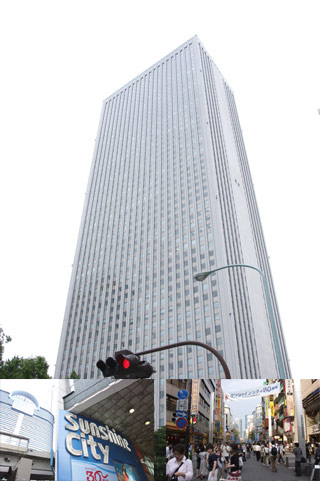Ikebukuro, a part of Toshima ward, is a large commercial and entertainment district of Tokyo, Japan. It is the location of the Toshima ward offices, Ikebukuro station and several extremely large department stores.
At the center of Ikebukuro is the train and subway station, a huge urban gathering shared by the JR East lines, the Seibu Ikebukuro Line and the Tōbu Tōjō Line. It is one of the main commuter hubs in the western Yamanote area of Tokyo. Ikebukuro Station is the second busiest subway station in Japan, second only to Shinjuku Station. Approximately one million people pass through the station each day.
Around the station are the Seibu and Tōbu department stores. Seibu, written with the characters for "West" and "Musashi (province)" 西 武, is on the east end of the station and Tōbu, written with the characters for "East" and "Musashi" 東武, is on the west end. East of the station, on the site of Sugamo Prison, stands Sunshine 60, which was Tokyo's tallest building at the time of its construction. Otome Road, a leading shopping area for otaku products aimed at women, is located nearby. Marui and Mitsukoshi also have department stores in the area. The principal electronics retailer in Ikebukuro is Bic Camera.
The old village of Ikebukuro stood to the northwest of the station. Most of the area on which modern Ikebukuro is built was historically known as Sugamo. In the Taishō and Shōwa periods, the relatively low land prices attracted artists and foreign workers, who lent a somewhat cosmopolitan atmosphere to Ikebukuro. Until October 1, 1932 when Toshima ward was established, the area was an independent municipality of Ikebukuro-mura (池袋村).
The kanji for Ikebukuro literally means pond bag. Outside the west exit of Ikebukuro station near an entrance to the Yurakucho New Line is a small plaque explaining three origins of the name Ikebukuro. The first is that in the northeastern part of the village there was a lake shaped like someone holding a bag. The second is that there was once a large number of lakes in the area of various sizes (thus implying a bag full of lakes). The third is that long ago a turtle came out of the lake carrying a bag on its back.
There is a small statue of an owl located near the center of the city called Ikefukurō-zō (いけふくろう像), meaning lake owl statue. It may be a hint of the true origin of the name given to Ikebukuro, but it was more likely constructed as nothing more than a joke, a play on words and as a point of interest by the city administration. The play on words arises from the alternative meaning of 'fukuro' as 'owl' (although owl is pronounced with a long final 'oh', rather than a short 'o' in the word 'fukuro' for bag). Perhaps because of this, the owl statue has become a famous meeting place along the lines of the statue of Hachikō located outside of Shibuya Station.






